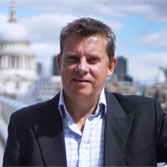Moscow honours Peter the Great with a 98m statue...of Christopher Columbus?

Moscow's controversial Peter the Great Statue is a 98-metre-high structure that looks something from Terry Guilliam's 'Adventures of Baron Munchausen' film. It sits on a promontory at the western confluence of the Moskva River and the Vodootvodny Canal in the centre of the city. Muscovites hate it as much as the real Peter the Great hated their city - so much so that it was the 2m tall Tzar who moved the country's capital to St Petersberg.
It weighs around a thousand tons and was erected in 1997 to commemorate the 300th anniversary of Peter the Great's founding of the Russian Navy by the Georgian-Russian artist Zurab Tsereteli (born January 4, 1934).

Peter at the helm of one of the world's worst statues. Photo My Bathroom Wall
It's not just Muscovites who loathe the statue - most tourists are left non-plussed too, and several times it's awfulness has been highlighted in various polls - being voted the tenth ugliest building in the world by Virtual Tourist in 2008, and it was included in a list of the world's ugliest statues by Foreign Policy magazine in 2010.
I know that I don't have to live with it on my horizon, but walking from Red Square, over the Bolshoy Moskvoretsky Bridge, and coming to the momument unexpectedly, and through the buzzing Park iskusstv Muzeon, I rather liked it. Putting the controversy to one side, in a city as heavy with dourness and brutish symbolism as Moscow, it felt like finding some whimsey, even if it is a gigantic twice-the-height-of-the-Staue-of-Liberty whimsey.
The artist Zurab Tsereteli is a pal of Moscow's former Mayor Yury Luzhkov, and has received several plum commissions under his patronage. But that mayor left office in 2010 and rumour has it that the current authorities lost little time in offering their dog's dinner of a statue to Saint Petersburg and other cities, but the offers were turned down.

The statue is across the water from the excellent Park Iskusstv. Photo My Bathroom Wall
Adding to its unloved status is the fact that many people are convinced that the statue is actually based on a design intended to commemorate Christopher Columbus. It's said that it was designed in 1992 to mark the 500th anniversary of Christopher Columbus' first voyage, but even that powerful peg seems to have left an entire continent unmoved. Once it was clear that an American home couldn't be found for it, it was tweaked by the artist and repurposed as Peter the Great.
Peter the Great, Christopher Columbus, or even Peter the Columbus; you be the judge?
Tsereteli denies the story, but my guide in the city pointed out that the ships piled under Peter are nothing like Russian ships of Peter's period, and instead look like 19th Century Spanish Caravel of the type contemporary with Columbus.

Seventeenth century European naval ships, or 19th century Spanish galleons? Photo My Bathroom Wall
Two more things...
Zurab Tsereteli's Columbus statue in Puerto Rico. This similarly colossal statue is about twice the height of New York's Statue of Liberty or Rio's Christ the Redeemer, and was also designed by Tsereteli, who began the work in 1991. It was gifted to the people of Columbus, Ohio (who awkwardly said no thanks, it's too ugly), Cleveland (likewise), and then it was snubbed by Baltimore, Boston, Ft Lauderdale, Miami, and New York.

Arecibo's Columbus statue was dubbed 'Chris Kong' owing to its perceived ugliness
At least this time the controversy wasn't over the statue's central character, which does appear to be Christopher Columbus - it was completed in 1992 to commemorate the 500th anniversary of Columbus' landfall in the new world. But the 60-metre tall creation, known as Birth of the New World, was touted all over the USA until the Caribbean island of Puerto Rico finally gave in and ended the statue's 20 years in the wilderness by agreeing to stump up the $12m needed to build a plinth and assemble its 2,750 pieces of bronze and steel.
Since 14 June 2016 Tsereteli's Columbus has stood by Highway 681 outside the coastal town of Arecibo, 70 kilometres west of San Juan, but only after a petition by the Taino people objecting to anything that commemorates Columbus arrival in the new world - as for Puerto Rico, like elsewhere in the region, it lead directly to a genocide of native peoples.
Observers hate the small head, the over-long arms and the flippant raised-hand greeting most, plus sticklers have noted that the steering wheel being clutched by Columbus wasn't invented until 200 years after Columbus' voyage.
As if more evidence were needed as a litmus test in taste, presidential nominee Donald Trump likes it - “It’s got forty million dollars worth of bronze in it...” he told the New Yorker magazine in 1997, adding that “The mayor of Moscow has written a letter to Rudy Giuliani stating that they would like to make a gift of this great work....I am absolutely favorably disposed toward [the statue]".
Peter the Great in Deptford, London. There is a curious statue of Peter the Great in Deptford, London too. It pays tribute to the fact that Peter made a three-month visit the city in 1698, on a reconnaissance trip to help create Russia's navy. Despite being the first Tzar to venture abroad for over a hundred years, mystery surrounds aspects of the visit, but it seems he travelled disguised as one Peter Mikhailov. He met the King and several other movers and shakers, but informally and without the pomp of a state visit, and eventually relocated to Sayes Court in Deptford, so as to be closer to the shipyards.
The house in Deptford - long since demolished - belonged the the English writer and diarist, John Evelyn. Peter seems to have trashed the place, leaving over 50 chair damaged or broken up for firewood, 300 windows broken and 25 paintings damaged. The property eventually became a workhouse, and these days is a development of flats.
The surreal ensemble includes a pin-headed Peter, a dwarf and an empty chair. The dwarf is apparently reference to Peter's fascination with human exotica, as perceived in 17th Century Europe anyway, and this chap was his favourite court dwarf. The chair is his travelling throne.

The curious Peter the Great ensemble in Deptford, London. Photo diamond geezer/Flickr
***
 |
Moscow seems to be underrated as a city break destination, largely because of the hassle and expense of getting a visa, plus owing to the relative distance from much of western Europe. The visa cost does make it tempting to visit St Petersburg in the same trip, or even to tour the famous Golden Ring of ancient Russian cities to the northeast of Moscow. |
 |
Moscow has several airports, the largest of which are Sheremetyevo Airport, which is 29 kilometres northwest of Moscow, and handled 31m passengers in 2015, and Domodedovo, which is 42 kilometres southeast of the city and handled 30m passengers in 2015. There are flights to Moscow from all across Europe, plus from Asia, Africa and the Americas. See Aeroflot, S7 Airlines. |
 |
The best time to visit Moscow is probably in the Spring, when temperatures reach the 50s and 60s, the sun shines for much of the days, and hotel prices are manageable. Summer are great too, with late evenings and warm temperatures - though it can get hot and gritty at times, plus very busy with tourists, and there is a spike in hotel prices. Winter has its special atmosphere in the city, but it can get extremely cold. |
 |
I travelled to Moscow as a guest of Political Tours, which specialises in running politically focussed tours in a number of the world's more contentious regions. Or try the Russia Experience or Cox & Kings. See the Russian National Tourist Office |





